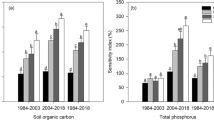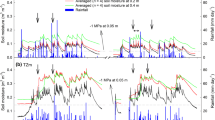Abstract
Nutrient inputs into crop production systems through fertilisation have come under increased scrutiny in recent years because of reduced nutrient use efficiency and increased environmental impact. Fifteen years of experimental data on dynamics of N, P and K in soil, crop yield and nutrient uptake from nine fertilisation treatments at Zhengzhou, North China Plain, were used to analyse the contribution of different fertilisation treatments to crop yield, nutrient use efficiency and accumulation of nutrients in soil. The results showed that both N and P were limiting factors for crop growth. Without additional N and P fertilisation, only a very low yield level (ca 2 t ha−1 for wheat and 3 t ha−1 for maize) could be maintained. To achieve the potential productivity (i.e. yield level free of water and nutrient stresses) of wheat (6.9 t ha−1) and maize (8.3 t ha−1), wheat would need, on average, 170 kg N ha−1, 32 kg P ha−1 and 130 kg K ha−1, while maize would need 189 kg N ha−1, 34 kg P ha−1 and 212 kg K ha−1. The N and P demands correspond well to the N and P levels supplied in one of the fertilisation treatments (NPK), while K deficiency could occur in the future if no crop residues were returned or no extra K was applied. On average under this NPK treatment, 80% of N and 71% of P could be recovered by the wheat–maize system. Treatments with nutrient inputs higher than the NPK treatment and treatments without combination of N and P have led to accumulation of N and P in the soil profile. The input levels of N and P in the NPK treatment are recommended in fertiliser management, with additional K to avoid future soil K deficiency.






Similar content being viewed by others
References
Cai GX, Chen DL, Ding H, Pacholski A, Fan XH, Zhu ZL (2002) Nitrogen losses from fertilizers applied to maize, wheat and rice in the North China Plain. Nutr Cycl Agroecosyst 63:187–195
Cassman KG, De Datta SK, Amarante ST, Liboon SP, Samson MI, Dizon MA (1996) Long-term comparison of the agronomic efficiency and residual benefits of organic and inorganic nitrogen sources for tropical lowland rice. Exp Agric 32:427–444. doi:10.1017/S0014479700001514
Chen C, Wang E, Yu Q (2009) Modelling the effects of climate variability and water management on crop water productivity and water balance in the North China Plain. Agr Water Manage. doi:10.1016/j.agwat.2008.11.012
Davis RL, Patton JJ, Teal RK (2003) Nitrogen balance in the Magruder plots following 109 years in continuous winter wheat. J Plant Nutr 26:1561–1580. doi:10.1081/PLN-120022364
Fang Q, Yu Q, Wang E, Chen Y, Zhang G, Wang J, Li LH (2006) Soil nitrate accumulation, leaching and crop nitrogen use as influenced by fertilization and irrigation in an intensive wheat–maize double cropping system in the North China Plain. Plant Soil 284:335–350. doi:10.1007/s11104-006-0055-7
Giles J (2005) Nitrogen study fertilizes fears of pollution. Nature 433:791. doi:10.1038/433791a
Guo H, Li G, Zhang D, Zhang X, Lu C (2006) Effects of water table and fertilization management on nitrogen loading to groundwater. Agric Water Manage 82:86–98. doi:10.1016/j.agwat.2005.07.033
He C, Liu X, Fangmeier A, Zhang F (2007) Quantifying the total airborne nitrogen input into agroecosystems in the North China Plain. Agric Ecosyst Environ 121:395–400. doi:10.1016/j.agee.2006.12.016
Heckrath G, Brookes PC, Poulton PR, Goulding KWT (1995) Phosphorus leaching from soils containing different phosphorus concentrations in the broadbalk experiment. J Environ Qual 24:904–910
Hossain MF, White SK, Elahi SF, Sultana N, Choudhury MHK, Alam QK, Rother JA, Gaunt JL (2005) The efficiency of nitrogen fertiliser for rice in Bangladeshi farmers’ fields. Field Crops Res 93:94–107
Hu C (2002) Managing soil fertility for sustainable agriculture in Taihang Mountain Piedmont, North China. In: McVicar TR, Li R, Walker J, Fitzpatrick RW, Liu C (eds). Regional water and soil assessment for managing sustainable agriculture in China and Australia. ACIAR Monograph No. 84 [online: http://www.eoc.csiro.au/aciar/book/]. ACIAR, Canberra, 165–172
Jenkinson DS (1991) The Rothamsted long-term experiments: are they still of use? Agron J 83:2–10
Keating BA, Carberry PS, Hammer GL, Probert ME, Robertson MJ, Holzworth D, Huth NI, Hargreaves JNG, Meinke H, Hochman Z, McLean G, Verburg K, Snow V, Dimes JP, Silburn M, Wang E, Brown S, Bristow KL, Asseng S, Chapman S, McCown RL, Freebairn DM, Smith CJ (2003) An overview of APSIM, a model designed for farming systems simulation. Eur J Agron 18:267–288. doi:10.1016/S1161-0301(02)00108-9
Lin Z, Zoebisch MA, Chen G, Feng Z (2006) Sustainability of farmers’ soil fertility management practices: a case study in the North China Plain. J Environ Manage 79:409–419. doi:10.1016/j.jenvman.2005.08.009
Liu C, Zhang X, Zhang Y (2002) Determination of daily evaporation and evapotranspiration of winter wheat and maize by large-scale weighing lysimeter and micro-lysimeter. Agric For Meteorol 111:109–120. doi:10.1016/S0168-1923(02)00015-1
Liu GD, Wu WL, Zhang J (2005) Regional differentiation of non-point source pollution of agriculture-derived nitrate nitrogen in groundwater in northern China. Agric Ecosyst Environ 107:211–220. doi:10.1016/j.agee.2004.11.010
Mo X, Liu S, Lin Z, Xu Y, Xiang Y, McVicar TR (2005) Prediction of crop yield, water consumption and water use efficiency with a SVAT-crop growth model using remotely sensed data on the North China Plain. Ecol Modell 183:301–322. doi:10.1016/j.ecolmodel.2004.07.032
Mullen RW, Freeman KW, Johnson GV, Raun WR (2001) Long-term wheat fertility research. Better Crops 85:6–8
National Bureau of Statistics of China (2004) Yearbook. Chinese Statistic Press, Beijing, p 8
Page AL, Millar RH, Keeney DR (1982) Methods of soil analysis: part 2. American society of Agronomy, Soil Science Society of America, Madison
Qin M, Zhao J (2001) Soil quality and sustainable land use in urban-rural marginal area: a case study of Kaifeng. J Geogr Sci 11:356–365
Schipper LA, Percival HJ, Sparling GP (2004) An approach for estimating when soils will reach maximum nitrogen storage. Soil Use Manage 20:281–286. doi:10.1079/SUM2004255
Thomas RL, Sheard R, Moyer JR (1967) Comparison of conventional and automated procedures for nitrogen, phosphorus, and potassium analysis of plant material using a single digestion. Agron J 59:240–243
Walkley A, Black IA (1934) An examination of the Degjareff method for determining SOM and a proposed modification of the chromic acid titration method. Soil Sci 37:29H–38H. doi:10.1097/00010694-193401000-00003
Wang L, Li W, Ma Y, Wang Y (2004) Study of the impact of bio-organic fertilizer on crop growth, soil fertility and yield. Soils Fert 5:12–16 in Chinese with English abstract
Wang L, Zheng Y, Yu Q, Wang E (2007) Applicability of agricultural production systems simulator (APSIM) in simulating the production and water use of wheat-maize continuous cropping system in North China Plain. Chin J Appl Ecol 18:2408–2486 in Chinese with English abstract
Wang L, Qiu J, Tang H, Li H, Li C, Ranst EV (2008) Modelling soil organic carbon dynamics in the major agricultural regions of China. Geoderma 147:47–55. doi:10.1016/j.geoderma.2008.07.009
World reference base for soil resources (1998) Food and Agriculture Organization of the United Nations, Rome. 84 World Soil Resources Reports
Xing GX, Zhu ZL (2002) An assessment of N loss from agricultural fields to the environment in China. Nutr Cycl Agroecosyst 57:67–73. doi:10.1023/A:1009717603427
Zhang WL, Tian ZX, Zhang N, Li XQ (1996) Nitrate pollution of groundwater in northern China. Agric Ecosyst Environ 59:223–231. doi:10.1016/0167-8809(96)01052-3
Zhang X, Chen S, Liu M, Pei D, Sun H (2005) Improved water use efficiency associated with cultivars and agronomic management in the North China Plain. Agron J 97:783–791. doi:10.2134/agronj2004.0194
Acknowledgments
We thank the National Basic Research Program (2005CB121102), the Key Technologies R&D Program of China (2006BAD05B01) and the National Science and Technology Support Plan (2006BAD17B09) for providing funding for this work and all scientists associated with the Long-term Experiment in Henan, China for their valuable work. We also thank CSIRO-MOE PhD Research Fellowship Program for providing the senior author of this paper the research opportunity in CSIRO Land and Water, Australia.
Author information
Authors and Affiliations
Corresponding author
Rights and permissions
About this article
Cite this article
Wang, Y., Wang, E., Wang, D. et al. Crop productivity and nutrient use efficiency as affected by long-term fertilisation in North China Plain. Nutr Cycl Agroecosyst 86, 105–119 (2010). https://doi.org/10.1007/s10705-009-9276-5
Received:
Accepted:
Published:
Issue Date:
DOI: https://doi.org/10.1007/s10705-009-9276-5




